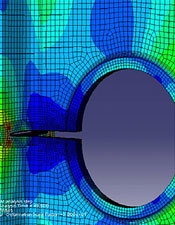Dec 4 2013
A Chicago-based consortium led by Northwestern University has been awarded $25 million over five years from the National Institute of Standards and Technology (NIST), an agency of the U.S. Department of Commerce, to establish a new center of excellence for advanced materials research.
 A computer model of crack growth in a part from a helicopter rotor. Colors indicate stresses surrounding the crack (red is high and blue is low). Such computations will be a key part of the Center for Hierarchical Materials Design’s research.
A computer model of crack growth in a part from a helicopter rotor. Colors indicate stresses surrounding the crack (red is high and blue is low). Such computations will be a key part of the Center for Hierarchical Materials Design’s research.
The Center for Hierarchical Materials Design (CHiMaD) will focus on developing the next generation of computational tools, databases and experimental techniques to enable the design of novel materials, one of the primary goals of the Obama administration’s Materials Genome Initiative (MGI).
Other members of the CHiMaD consortium include the University of Chicago, the Northwestern-Argonne Institute of Science and Engineering (a partnership between Northwestern and the Department of Energy’s Argonne National Laboratory) and the Computation Institute (a partnership between the University of Chicago and Argonne).
Only one award was made in the national competition.
“The Center for Hierarchical Materials Design will serve as an anchor for the city of Chicago’s effort to become an international hub for high-tech innovation,” said Northwestern’s Peter W. Voorhees, one of three co-directors of the new center.
“Building on a long history of collaborations with NIST researchers, the center will bring together the next generation of state-of-the-art computational methods, curated materials databases and novel integrated experimental methods to design new materials,” he said.
Voorhees is the Frank C. Engelhart Professor of Materials Science and Engineering in the McCormick School of Engineering and Applied Science.
The other co-directors are Gregory B. Olson, the Walter P. Murphy Professor of Materials Science and Engineering at Northwestern, and Juan de Pablo, the Liew Family Professor in Molecular Engineering at the University of Chicago.
“This center will build the primary foundation of the national Materials Genome Initiative,” Olson said.
“The consortium serves to emphasize the growing preeminence of the city of Chicago as an epicenter for world-class advanced materials research,” de Pablo said. “The concentration of talent and experimental resources provided by Northwestern, the University of Chicago and Argonne, as well as other premier universities in the city is, increasingly, a magnet for advanced research initiatives such as the NIST Advanced Materials Center of Excellence.”
The consortium also plans to work closely with the pioneering materials design company QuesTek Innovations, a small business spin-off of Northwestern, co-founded by Olson; ASM International, a well-known professional society of materials scientists; and Fayetteville State University. A strong cast of supporting industrial collaborators from across the nation will further enhance the mission of the CHiMaD consortium.
Designing materials employs physical theory, advanced computer models, vast materials properties databases and complex computations to accelerate the design of a new material with specific properties for a particular application -- perhaps an extremely tough, light-weight composite for automobile bodies or a biocompatible cell scaffold for medicine. This approach stands in contrast to the traditional trial-and-error method of materials discovery. (Think of Thomas Edison and his dogged quest for the best light bulb filament.)
The new center’s work is expected to encompass both “hard” (inorganic) and “soft” (organic) advanced materials in fields as diverse as self-assembled biomaterials, smart materials for self-assembled circuit designs, organic photovoltaic materials, advanced ceramics and metal alloys.
CHiMaD will focus these techniques on a particularly difficult challenge, the creation of novel “hierarchical materials.” Hierarchical materials exploit distinct structural details at various scales from the atomic on up to achieve special, enhanced properties. An example in nature of a hierarchical material is bone, a composite of mineral and protein at the molecular level assembled into microscopic fibrils that in turn are assembled into hollow fibers and on up to the highly complex material that is “bone.”
“I’m particularly excited to announce this new alliance between NIST and two prominent research universities to drive innovation in the development of advanced materials,” said Patrick Gallagher, Under Secretary of Commerce for Standards and Technology and NIST director. “This new Center for Hierarchical Materials Design is a natural fit for NIST, which has a long tradition of serving as a nexus with academia and industry to advance research and innovation for the nation’s benefit.”
Techniques for designing materials have the potential to revolutionize the development of new advanced materials, which in turn have created whole industries. It’s estimated that the average time from laboratory discovery of a new material to its first commercial use can take up to 20 years. The Materials Genome Initiative aims to halve that.
“The launch of this new center represents a major milestone in support of the president’s Materials Genome Initiative and our national goal of doubling the pace of discovery and development of novel materials,” said Cyrus Wadia, assistant director for Clean Energy and Materials R&D at the White House Office of Science and Technology Policy.
“By integrating the complementary strengths of computation, instrumentation and creative modeling, this center promises to help keep America at the forefront of the materials revolution and a leader in the economically important domain of advanced manufacturing,” Wadia said.
The award to the Northwestern-led consortium for the Center for Hierarchical Materials Design is for $5 million per year for five years, subject to available funds. NIST may, at its discretion, extend the award for an additional five years after a performance review. The consortium is contributing another approximately $4.65 million to the center.
-Megan Fellman, science and engineering editor at Northwestern, and Michael Baum of NIST Public Affairs contributed to the story.